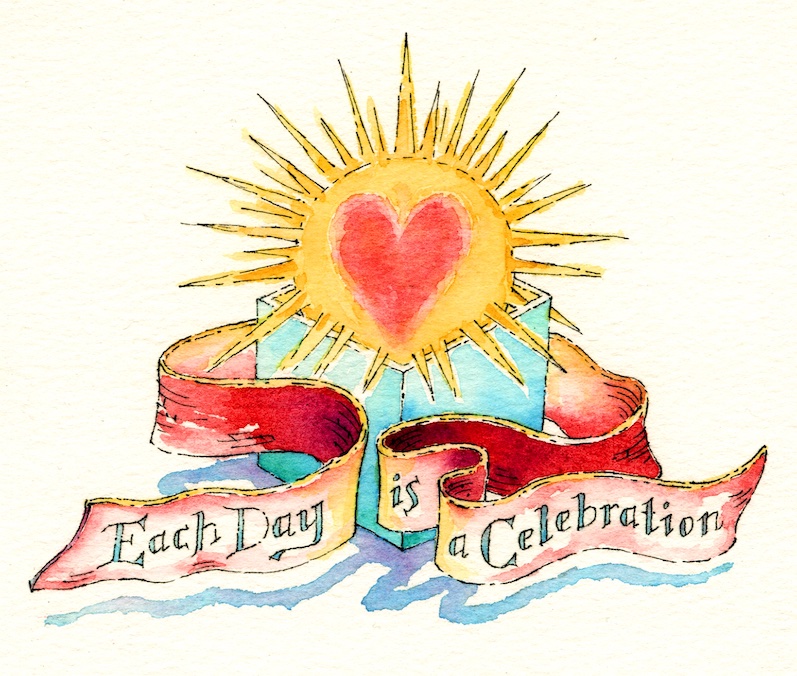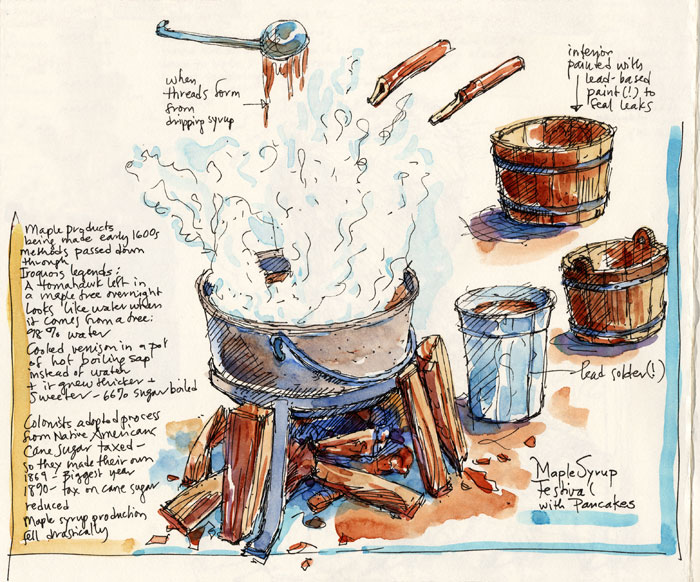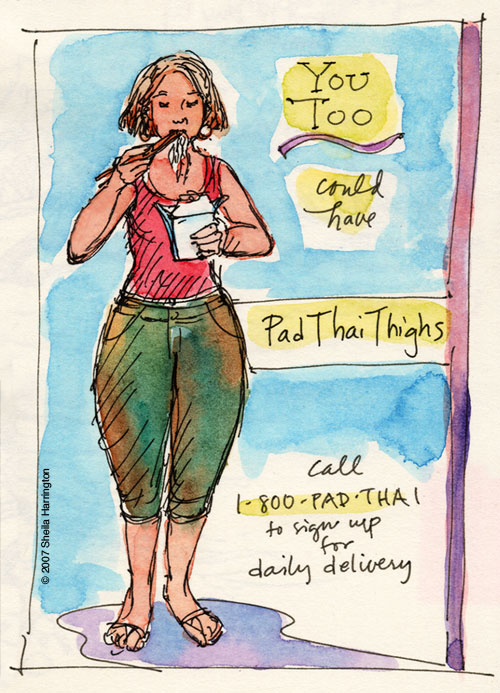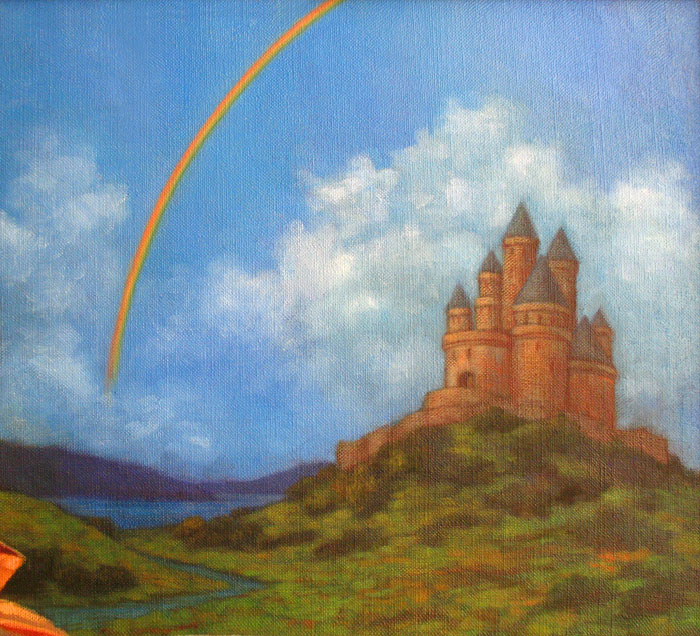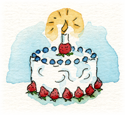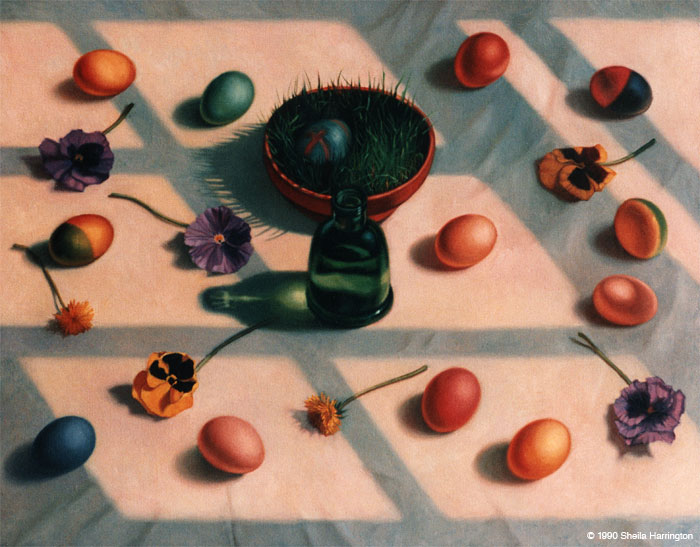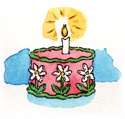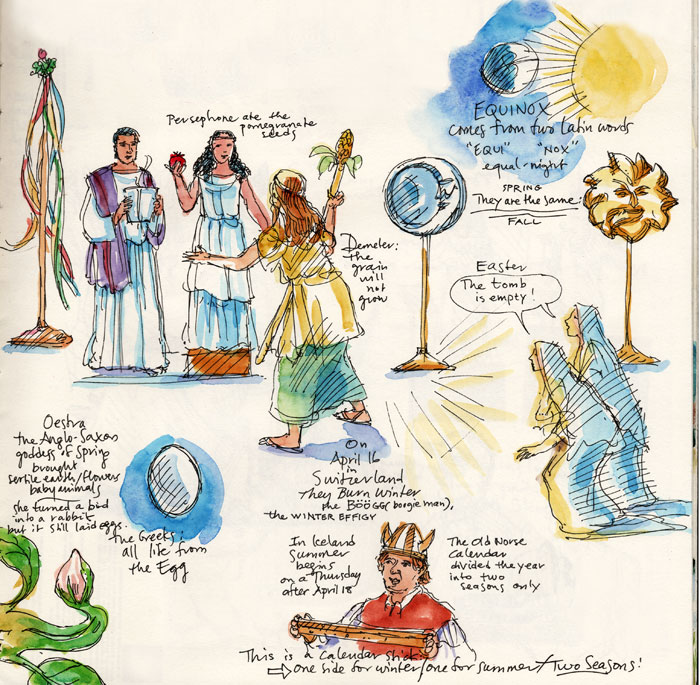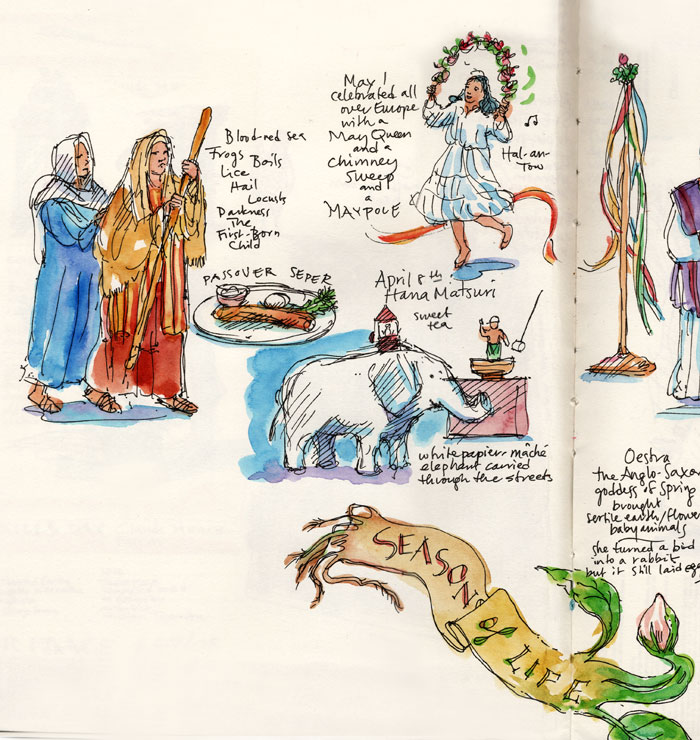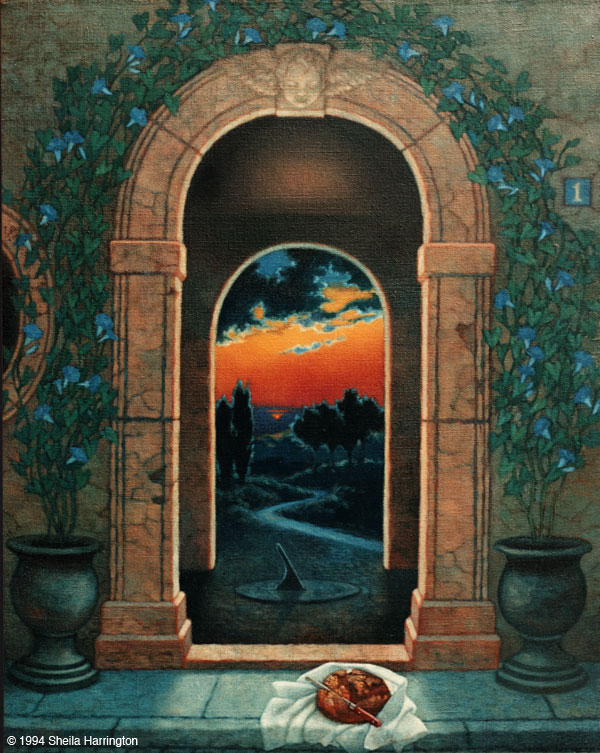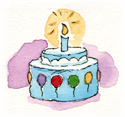A sketching expedition with my daughter last spring.
Month: April 2010
Sugaring off
Spring is a time for field trips—outdoors, if possible. This is from my sketchbook, when, as part of a homeschooling Farming block one year, we visited Cunningham Falls in the Catoctin Mountains for their annual maple syrup festival. We were able to see the entire process from tree-tapping to boiling down sap to sampling the final product at a pancake breakfast. Wonderful park guides provided explanations of each step and answered our many questions. The syrup was a whole lot better than their Lake Wobegon pancakes, though. They definitely need a new recipe.
Pad Thai Thighs
My Heart Leaps Up
My heart leaps up when I behold
A rainbow in the sky.
So was it when my life began;
So is it now I am a man;
So be it when I grow old,
Or let me die!
The Child is father of the Man;
And I could wish my days to be
Bound each to each by natural piety.
—William Wordsworth
(painting is a detail from a larger work, The Age of Reason)
Whenever someone in the family mentions a rainbow, my husband launches into this poem. (It’s now inevitably become a sort of family tradition—wait for it….) And today we celebrate the fortuitous birthday of its author, William Wordsworth (1770-1850), born in Cumberland, England.
Is it obligatory for English poets to have had unhappy childhoods? Wordsworth’s was no exception—his father, mysteriously, lived apart from the family, and when the children’s mother died, instead of taking them in, he parcelled them out between boarding schools and a series of unpleasant misery-inducing relatives. Wordsworth wasn’t reunited with his beloved favorite sister Dorothy for years. The highlight of his dismal schooling (besides introducing him to his future wife) was the holidays, which he consistently spent going long walks in nature and writing poetry.
At twenty Wordsworth set off on a walking tour of Italy, Switzerland, and post-Revolutionary France, where he became a passionate advocate of the republican cause. In France he formed a liaison with a local girl, but the relationship was discouraged by her parents (despite his having fathered a daughter whom he visited and supported rather erratically over the years). He returned home alone, disillusioned by the increasing violence of the revolution and England’s violent response to it, aimless, without profession, depressed.
This dark period was finally relieved by a legacy from Raisley Calvert, a sculptor and loyal former classmate, that allowed Wordsworth to support himself while writing poetry. May we all be so fortunate in our old school friends! With a steady income, he was able to form a household with Dorothy and their mutual friend Samuel Coleridge that Dorothy termed “three persons with one soul.”
It was a creative partnership that marked the birth of English Romanticism. Inspired by one another, Wordsworth and Coleridge produced innovative, experimental, controversial poetry, and Dorothy’s letters (luckily for literary historians) documented the process. Wordsworth defined poetry as “the spontaneous overflow of powerful feelings” but his rapture was borne within measured frameworks, among them the sonnet form, which Wordsworth reawakened after its long disuse. In 1798 they published Lyrical Ballads (“Tintern Abbey,” “The Idiot Boy,” “Rime of the Ancient Mariner”) and Romanticism was up and running.
The Romantic movement emphasized the value of individual experience, the contributions of ethnic traditions and folklore, the primal power of wild landscape and the wonders of nature, a consciousness of the infinite, and the use of imagination and the senses as a path to spiritual truth. It was a break from the formal elegance, polish, dignity and conservative restraint that characterized the formerly hot movement, Neoclassicism. Instead of, say, a series of elevated dramatic couplets on the epic semi-divine hero of ancient tragedy, we have a lyrical meditation on the soul-response to a sea of daffodils, or to the loss of a much-loved child. A personal perspective on life, the natural world, and mortality.
Yes…quite a break! taken up by Blake, Scott, and Göethe, followed by a whole string of younger Romantic poets and writers (Byron, Shelley, Keats, Hugo, Dumas, Pushkin) and the Transcendentalists (Emerson, Thoreau) and later the Victorians (Browning, Tennyson). Where would it end?? Culture as well as politics seems to be an ongoing struggle between the poles of head and heart, with adherents of each movement certain of having achieved a universally valid means of expression. But that is a subject for another post.
The partnership foundered on a falling-out with Coleridge, a pretty gloomy fellow, as one would expect of someone who writes a lengthy baffling poem about a curse-bearing dead albatross. Wordsworth and Dorothy moved on, settling eventually in the beautiful Lake District, that region abundant in literary inspiration and indomitable tourists. Joined by Robert Southey, the two became known as the “Lake Poets,” and Wordsworth married and proceeded to have five children. A sizable household. But a household that, as any other, had its share of suffering, with the drowning of William and Dorothy’s brother, and the deaths of three of the children. Wordsworth’s poetry grew more sober, restrained, and elegiac. In fact in his later years, while serving as England’s poet laureate, he was criticized by younger writers for his increasing conservatism. Suffering and loss does shade and temper youthful abandon.
Even if you can’t recite a Romantic poem in entirety, you know that your head is filled with lovely memorable fragments (“Dear God! the very houses seem asleep; And all that mighty heart is lying still…” “I wandered lonely as a cloud That floats on high o’er vales and hills…” “The Soul that rises with us, our life’s Star, Hath had elsewhere its setting, And cometh from afar…”) that are part of our literary legacy and that emerge in moments of wonder and joy. For the fragments, for the poetry, for the consciousness that shaped them, and for my husband’s regular recital of the rainbow poem, thank you, William Wordsworth, and Happy Birthday.
Cherry Blossom Breakfast
This morning we officially began our homeschooling Botany block, with springtime poetry, an early morning picnic and stroll under the cherry blossoms, and a long conversation about the astonishing, exuberant and generous world of plants, which brings forth hourly surprises in this season. (Was it only last month that a mountain of snow still blocked the alley exit?)
Lo, the winter is past, the rain is over and gone;
the flowers appear on the earth;
the time of the singing of birds is come,
and the voice of the turtle is heard in our land.
The fig tree putteth forth her green figs,
and the vines with the tender grape give a good smell.
Arise, my love, my fair one, and come away.
—Song of Solomon 2:11-13
Down on the Farm
Each spring at this time, the children of our homeschooling coop spend a week on a working farm. They feed the animals, gather eggs, milk cows, spread manure, plant seeds, work on meal preparation and cleanup, and generally help out with whatever needs to be done. This year they also participated in gathering and boiling sap for maple syrup, which they then ate with their pancakes the next morning. When we parents go to fetch them at the end of the week, they are muddy, tired, and already looking forward to returning next year. We always hope the children will come home begging for a few more chores to be added to their lists. Maybe if we kept a cow…
Easter Garden
Some years ago I was moved to paint a still life based on our Easter customs.
Every year during Lent we plant a tiny garden of rye or clover seed and set it in the middle of the dining room table. And every year it’s startling (even though I’ve seen it so often before!) to find one morning that new, fragile green sprouts have pushed their way upward through the weight of earth. What fortitude. What will to live. So may we all find our way toward the light this springtime season.
Season of Life 2
Season of Life 1
Each year Discovery Theater at the Smithsonian offers a performance in celebration of spring festivals in various cultures. My daughter and I attended as part of a homeschoolers’ outing, and I took along my sketchbook. The homages to the season were skillfully woven together with music, dancing, brief dramatic episodes, and rapid costume and prop changes by the very small yet impressive multi-talented cast. It was lively and engaging, but really tough to sketch and make notes! More like a series of scrawls. Since these fill a spread of my sketchbook, it’s too big for one post, so just the left side today: Passover, the Maypole, and Hana Matsuri.
Holy Thursday
‘Twas on a holy Thursday, their innocent faces clean,
The children walking two and two in red and blue and green:
Grey-headed beadles walked before, with wands as white as snow,
Till into the high dome of Paul’s they like Thames waters flow.
O what a multitude they seemed, these flowers of London town!
Seated in companies they sit, with radiance all their own.
The hum of multitudes was there, but multitudes of lambs,
Thousands of little boys and girls raising their innocent hands.
Now like a mighty wind they raise to heaven the voice of song,
Or like harmonious thunderings the seats of heaven among:
Beneath them sit the aged men, wise guardians of the poor.
Then cherish pity, lest you drive an angel from your door.
—William Blake
